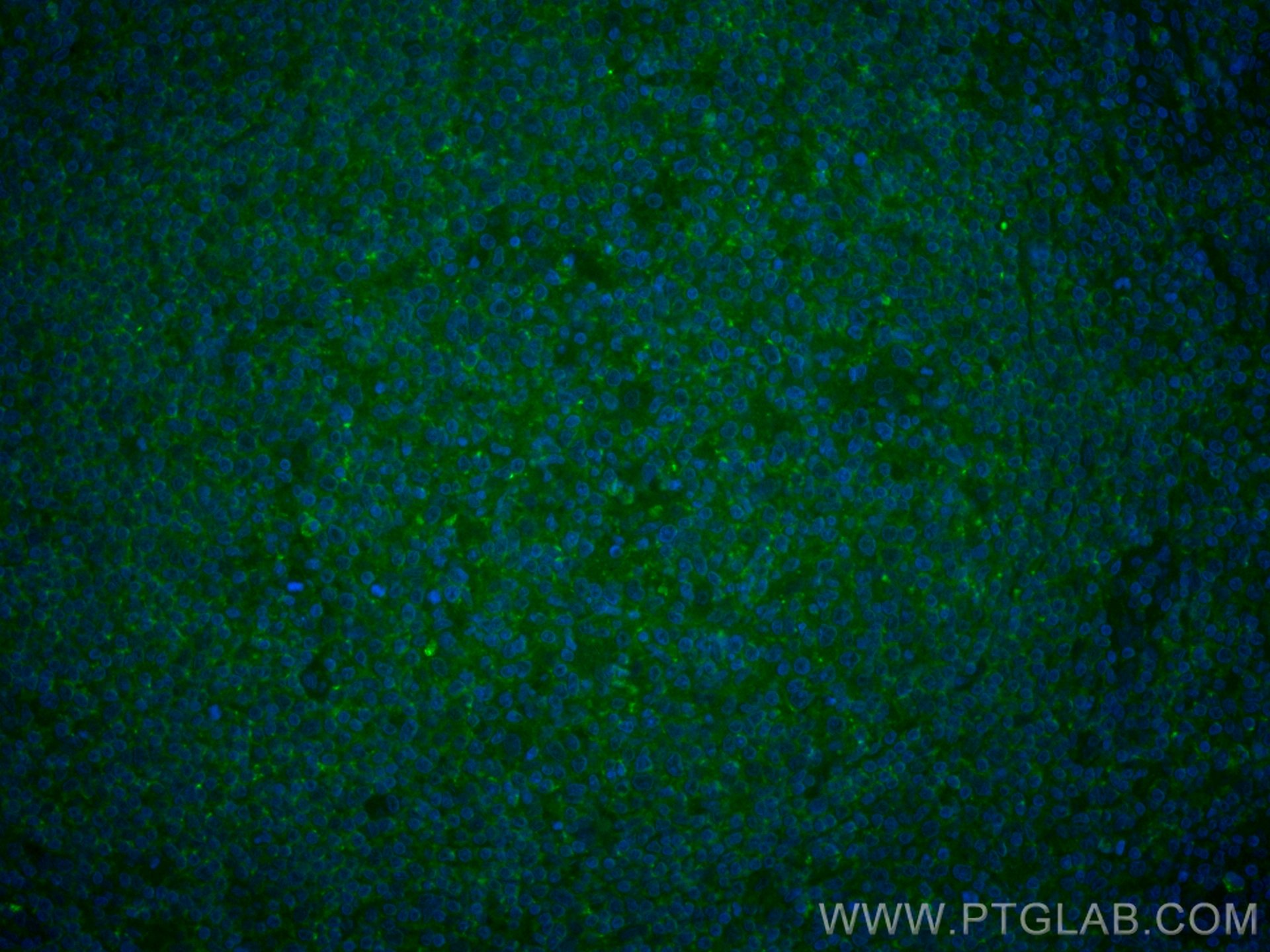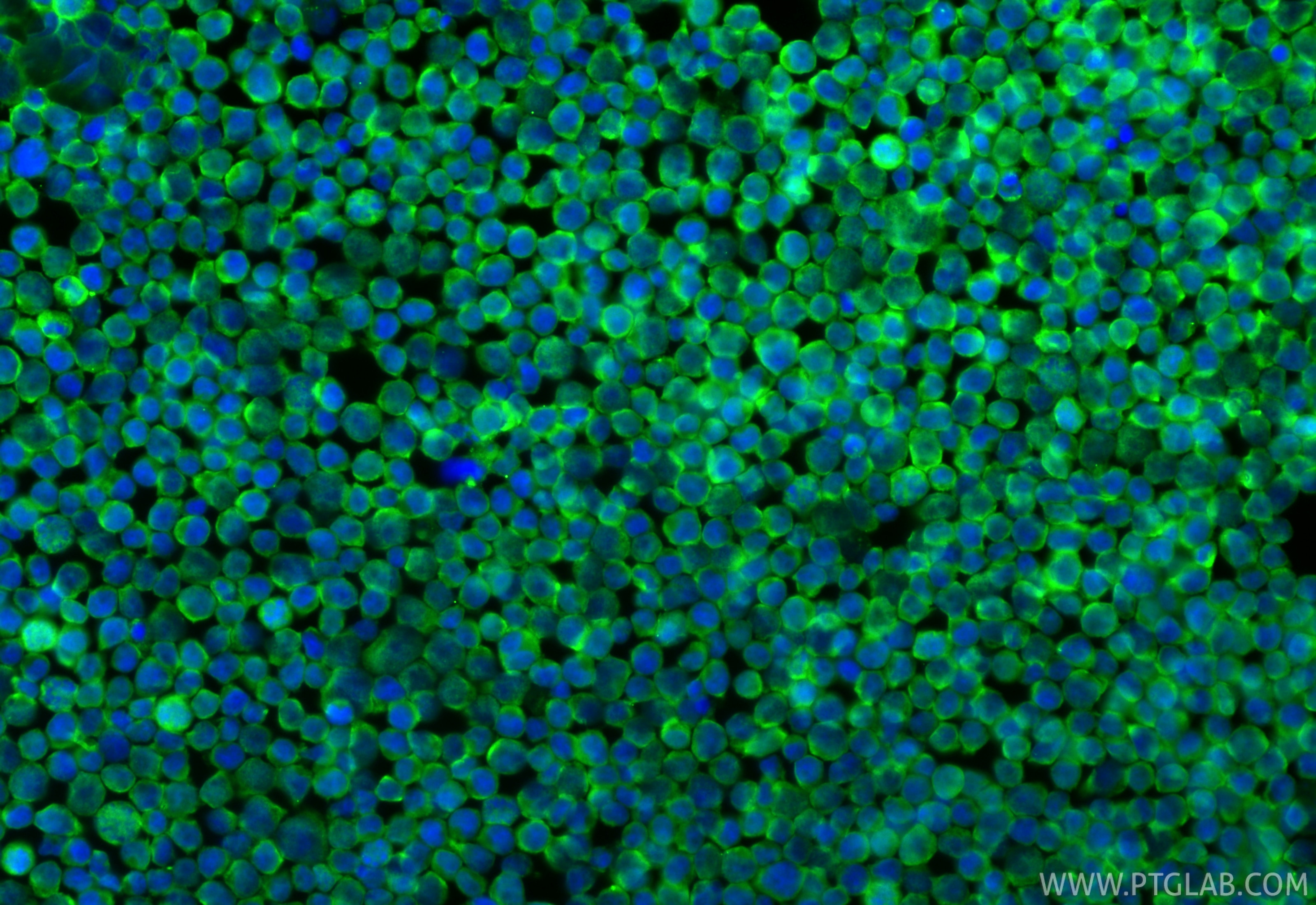CD45 Monoklonaler Antikörper
CD45 Monoklonal Antikörper für IF/ICC, IF-P
Wirt / Isotyp
Maus / IgG2a
Getestete Reaktivität
Hausschwein, human, Maus
Anwendung
IF/ICC, IF-P
Konjugation
CoraLite® Plus 488 Fluorescent Dye
CloneNo.
4E9B2
Kat-Nr. : CL488-60287
Synonyme
Geprüfte Anwendungen
| Erfolgreiche Detektion in IF-P | humanes Tonsillitisgewebe |
| Erfolgreiche Detektion in IF/ICC | Jurkat-Zellen |
Empfohlene Verdünnung
| Anwendung | Verdünnung |
|---|---|
| Immunfluoreszenz (IF)-P | IF-P : 1:50-1:500 |
| Immunfluoreszenz (IF)/ICC | IF/ICC : 1:50-1:500 |
| It is recommended that this reagent should be titrated in each testing system to obtain optimal results. | |
| Sample-dependent, check data in validation data gallery | |
Veröffentlichte Anwendungen
| IF | See 2 publications below |
Produktinformation
CL488-60287 bindet in IF/ICC, IF-P CD45 und zeigt Reaktivität mit Hausschwein, human, Maus
| Getestete Reaktivität | Hausschwein, human, Maus |
| In Publikationen genannte Reaktivität | human, Maus |
| Wirt / Isotyp | Maus / IgG2a |
| Klonalität | Monoklonal |
| Typ | Antikörper |
| Immunogen | CD45 fusion protein Ag13712 |
| Vollständiger Name | protein tyrosine phosphatase, receptor type, C |
| Berechnetes Molekulargewicht | 1304 aa, 147 kDa |
| Beobachtetes Molekulargewicht | 220 kDa |
| GenBank-Zugangsnummer | BC014239 |
| Gene symbol | CD45 |
| Gene ID (NCBI) | 5788 |
| Konjugation | CoraLite® Plus 488 Fluorescent Dye |
| Excitation/Emission maxima wavelengths | 493 nm / 522 nm |
| Form | Liquid |
| Reinigungsmethode | Protein-A-Reinigung |
| Lagerungspuffer | PBS with 50% glycerol, 0.05% Proclin300, 0.5% BSA |
| Lagerungsbedingungen | Bei -20°C lagern. Vor Licht schützen. Nach dem Versand ein Jahr stabil. Aliquotieren ist bei -20oC Lagerung nicht notwendig. 20ul Größen enthalten 0,1% BSA. |
Hintergrundinformationen
Protein tyrosine phosphatase receptor type C (PTPRC) is also known as CD45 antigen, which was originally called leukocyte common antigen (LCA). CD45 is an enzyme required for T-cell activation through the antigen receptor consisting of two intracellular phosphatase domains, a transmembrane domain and an extracellular domain. Upon T-cell activation, CD45 recruits and dephosphorylates SKAP1 via an interaction through the first PTPase domain, which is the only domain to possess intrinsic kinase activity. However, both domains are required for appropriate phosphatase and T-cell antigen receptor activity (PMID: 8076596).
What is the molecular weight of CD45?
The molecular weight of CD45 is a 180-240 kDa.
What are the isoforms of CD45?
Six different human isoforms of CD45 have been isolated, containing all three exons (ABC isoform), two of the three exons (AB and BC isoforms), only one exon (A isoform or B isoform), or no exons (O isoform). All of the isoforms have the same eight amino acids at their amino-terminus (PMID: 12412720).
What is the tissue specificity of CD45?
CD45 is a tyrosine phosphatase expressed on the plasma membrane of all hematopoietic cells, except erythrocytes and platelets (PMID: 7803253).
What are the post-translational modifications of CD45?
CD45 can be heavily N- and O-glycosylated (PMID: 1702721).
What is CD45's involvement in disease?
Defects in CD45 are a cause of severe combined immunodeficiency autosomal recessive T-cell-negative/B-cell-positive/NK-cell-positive (T(-)B(+)NK(+) SCID); a severe form of SCID. It is classed by the impairment of both humoral and cell-mediated immunity, leukopenia, and the low or absent levels of antibodies (PMID: 10700239). Also, genetic variants of CD45 have a role in susceptibility to multiple sclerosis (PMID: 12864992).
Protokolle
| PRODUKTSPEZIFISCHE PROTOKOLLE | |
|---|---|
| IF protocol for CL Plus 488 CD45 antibody CL488-60287 | Protokoll herunterladen |
| STANDARD-PROTOKOLLE | |
|---|---|
| Klicken Sie hier, um unsere Standardprotokolle anzuzeigen |
Publikationen
| Species | Application | Title |
|---|---|---|
J Virol Ex Vivo Infection of Human Skin with Herpes Simplex Virus 1 Reveals Mechanical Wounds as Insufficient Entry Portals via the Skin Surface | ||
Biosens Bioelectron Constructing a highly sensitive duplex immunoassay using AuNPs and AgNPs as nanolabels for investigating the epithelial-mesenchymal transition occurring on circulating tumor cells with lung cancer patients |



